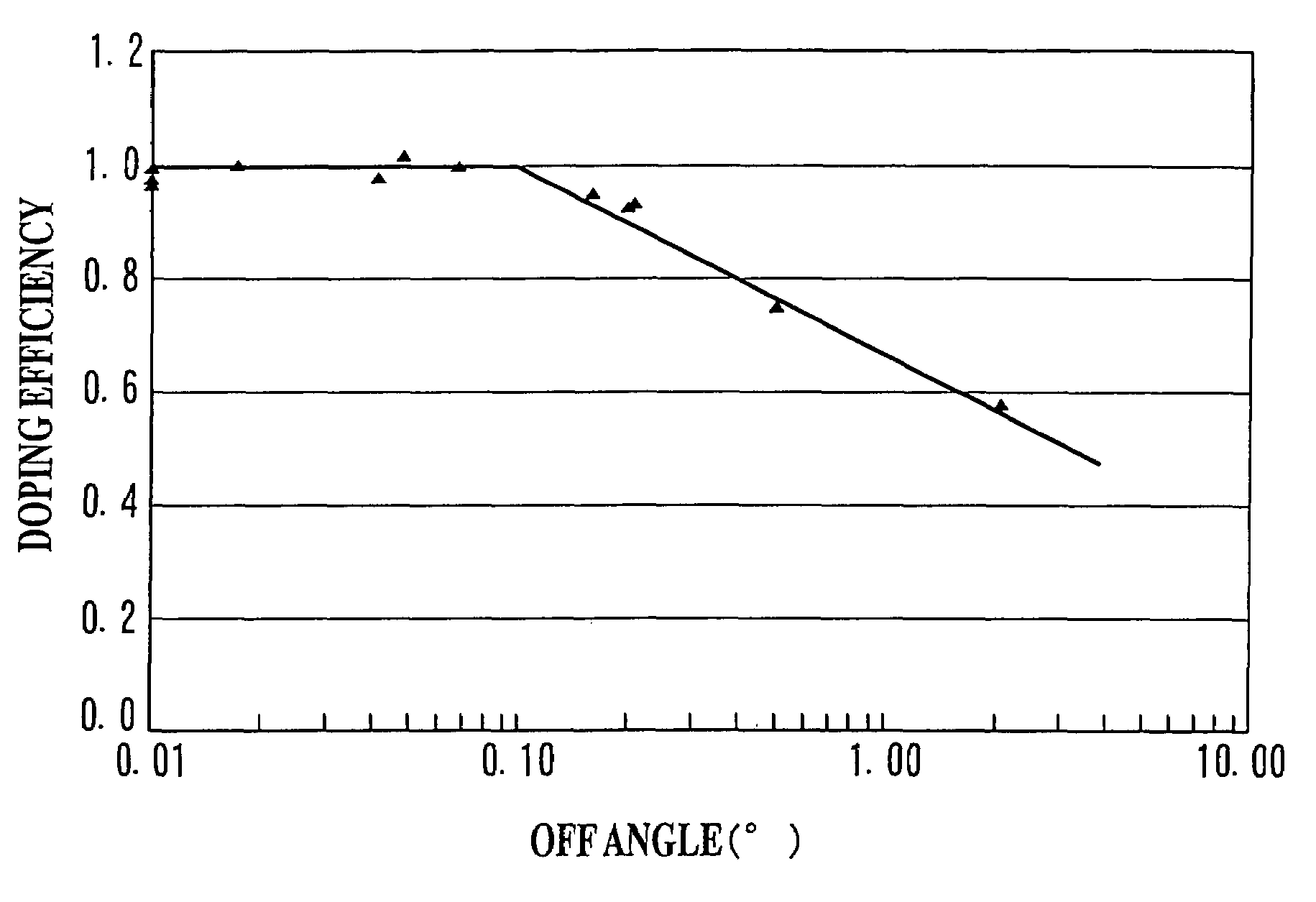Method for growing epitaxial crystal
a technology of epitaxial crystal and crystal growth, which is applied in the growth process of crystals, polycrystalline materials, chemically reactive gases, etc., can solve the problems of deteriorating production efficiency and inability to obtain desired carrier concentrations, and achieve the effect of improving production efficiency and changing doping efficiency
- Summary
- Abstract
- Description
- Claims
- Application Information
AI Technical Summary
Benefits of technology
Problems solved by technology
Method used
Image
Examples
example 1
[0041]By using InP substrate having an off angle of 0.15°, a diameter of 2 inches, an S-doped concentration of 4×1018 cm−3, and a thickness of 350 μm, an InP epitaxial crystal layer having a thickness of 1 μm and a target carrier concentration 1.2×1018 cm−3 was formed by the MOCVD method. Then, by considering the decrease of a doping efficiency to an off angle of 0.15° based on FIG. 1, the dopant flow rate was 1.05 times higher than that of the experiment (3). In the obtained epitaxial crystal layer, the haze was 2.5 ppm which is the same result as that of the above experiment (3). However, the carrier concentration was 1.18×1018 cm−3 that is closer to the target value.
example 2
[0042]By using a plurality of InP substrates having an off angle of 0.15±0.03°, a diameter of 2 inches, an S-doped concentration of 4×1018 cm−3, and a thickness of 350 μm, InP epitaxial crystal layers having a thickness of 1 μm and a target carrier concentration 1.2×1018 cm−3 were formed by the MOCVD method. Then, by considering the decrease of a doping efficiency to an off angle of 0.15° based on FIG. 1, the dopant flow rate was 1.05 times higher than that of the experiment (3). In the obtained epitaxial crystal layer, the haze was 2.5 ppm which is the same result as that of the above experiment (3). However, the carrier concentration was 1.17 to 1.22×1018 cm−3 that is closer to the target value. It is noted that in only InP substrates having an off angle of 0.15±0.02°, the carrier concentration was 1.19 to 1.22×1018 cm−3.
example 3
[0043]By using a plurality of InP substrates having an off angle of 0.05 to 0.10°, a diameter of 2 inches, an S-doped concentration of 6×1018 cm−3, and a thickness of 350 μm, InP epitaxial crystal layers having a thickness of 1 μm and a target carrier concentration 4.8×1017 cm−3 were formed by the MOCVD method. Then, because the carrier concentration of an epitaxial crystal layer was 4.8×1017 cm−3 in case of using a substrate having an off angle of 0.05° and in case of the doping flow rate of 47 sccm, the same doping flow rate was set in the present example. In the obtained epitaxial crystal layer, the haze was 1.04 to 1.35 ppm, the carrier concentration was 4.8±0.1×1017 cm×3, and the ratio of the doping efficiency was 1.0. Specifically, as shown in FIG. 1, the correction of doping conditions were not required in a range of an off angle of not more than 0.1°.
[0044]In the present example, for example, in a production run in which a doping condition (dopant flow rate) is previously kn...
PUM
| Property | Measurement | Unit |
|---|---|---|
| off angle | aaaaa | aaaaa |
| average off angle | aaaaa | aaaaa |
| off angle | aaaaa | aaaaa |
Abstract
Description
Claims
Application Information
 Login to View More
Login to View More - R&D
- Intellectual Property
- Life Sciences
- Materials
- Tech Scout
- Unparalleled Data Quality
- Higher Quality Content
- 60% Fewer Hallucinations
Browse by: Latest US Patents, China's latest patents, Technical Efficacy Thesaurus, Application Domain, Technology Topic, Popular Technical Reports.
© 2025 PatSnap. All rights reserved.Legal|Privacy policy|Modern Slavery Act Transparency Statement|Sitemap|About US| Contact US: help@patsnap.com


